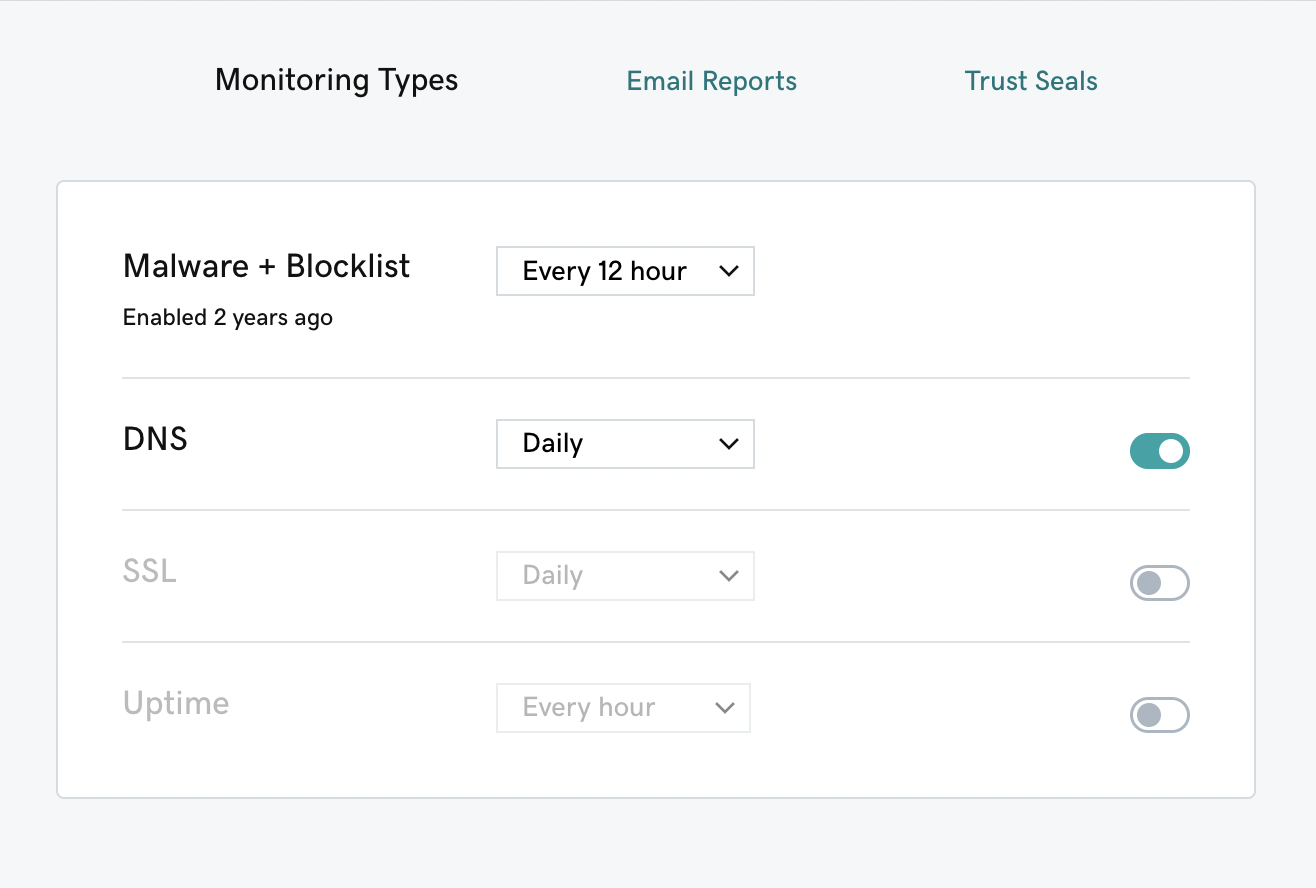Configure my website monitoring
Website Security provides several different website monitors that will notify you by email if something looks wrong with your site. When you set up your Website Security, you'll want to review and configure the Monitoring Types to make the most of your website protection.
- Go to your GoDaddy product page.
- Under Website Security and Backups, next to the site you want to configure, select Manage.
- Under Monitoring, select Details.
- The monitoring dashboard will appear with a list of sites that have monitoring enabled. Select the site you'd like additional monitoring types activated for.
- In the upper right corner, select Settings.
- Switch the toggle
 next to the monitoring type you wish to activate or deactivate.
next to the monitoring type you wish to activate or deactivate. - Once a monitoring type is activated, select the frequency of the scans from the dropdown list.

Configure website monitoring
- Go to your GoDaddy product page.
- Under Website Security and Backups, next to the site you want to configure, select Manage.
- Under Monitoring, select Details.
- You'll be directed to the Security Check page on the monitoring dashboard for the site selected. The different monitoring types can be navigated to through the links at the top of the page: Security Check, Uptime, SSL Scanner, and DNS Scanner. You can also reach the settings for Trust Seals and Weekly Statistics.
- On each of the scanning type pages, select the black box that says Activate.
Monitoring types
Remote Malware Monitoring (Security Check)Our Malware Monitoring identifies obfuscated javascript injections, cross site scripting, website defacements, hidden and malicious iframes, PHP mailers, phishing attempts, malicious redirects, backdoors, anomalies, drive-by-downloads, social engineering attacks, SEO blackhat spam, pharma hacks, conditional redirects and mobile redirects.
SSL MonitoringAn SSL (Secure Sockets Layer) is a certificate on the website that allows encryption of information from the client to the server. If your site uses an SSL certificate, it is important to know the status of the certificate in order to keep your customer’s Personal Identifiable Information safe (PII).
It's rare that your SSL certificate will change, but if it does, you will be alerted to any changes via email.
DNS MonitoringDNS is a protocol used by computers to communicate. It turns a website's name (coolexample.com, for example) into an Internet Protocol (IP) address like 123.45.567.891. The name provided by DNS is what we use as humans to read the website name. The IP is what the computers use to locate the website.
This monitoring option will monitor the IP address of your website, nameservers and MX records. It's rare for this information to change, but if it does we will notify you.
Blocklist MonitoringThere are a number of blocklisting authorities that monitor for malware, spam, and phishing attempts. You will be alerted if your site is blocklisted on any of the following:
- PhishTank
- Opera browser
- SiteAdvisor
- Sucuri Malware Labs blocklist
- Yandex (via Sophos)
- ESET
If you need any assistance with configuring these scans, please feel free to request website security help.
Uptime MonitoringUptime monitoring is a service that checks if a website is online and will send you an alert if your website is "down." After additional checks, an alert will be sent again when the website is back "up."
Two randomly assigned monitors from our fleet will send HTTP requests to your site at the specified uptime scan frequency. If the monitors don’t receive an identical response from your hosting server, the results are discarded. The scanners will follow a maximum of 5 redirects. A website is considered to be down if the host server returns an error or it times out.
More info
- After you've configured your website monitors, review these tips to keep your website clean.